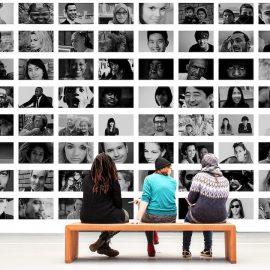
What drives human behavior? How can you use someone’s motivations to better understand them as a person?
Patrick King contends that to determine why a person behaves in a certain way, you must understand two aspects of their psyche: their motivations and personality. In Read People Like a Book, he examines each motivational factor a person has and their personality.
Continue reading for a deeper exploration of the psychology behind a person’s behavior.
1. Subconscious Urges
What drives human behavior? One factor is subconscious motivations. They come from the part of your psyche that psychologist Carl Jung called the shadow—the part we try to ignore, repress, and hide from others. In the shadow live sexual urges, creative urges, insecurities, dislikes, self-loathing, and so on. Because these live in the subconscious, you may not even be fully aware of these motivations at any given moment.
King contends that it’s not possible to permanently repress subconscious urges, and that eventually, these repressed feelings will motivate a person to behave in ways that might bring them harm—that might hurt a relationship, for example, or drive them to make poor financial decisions. For instance, a lawyer who’s long repressed a desire to write poetry might criticize the efforts of a friend who was recently published, or a person who secretly longs to be fabulously wealthy might impulsively buy a risky stock.
King writes that when you can identify the subconscious motives of another person, you’ll know how to engage them more effectively. You might even be able to manipulate them if you know how to appeal to their secret desires and fears. You’re also less likely to be emotionally hurt by their bad behavior if you can recognize that it’s motivated by fear, anger, self-loathing, or other negative, repressed emotions.
2. The Pleasure Principle
King writes that people are often motivated by the pleasure principle: the desire to pursue pleasure and avoid pain. It’s our most basic, primitive motivator, and it drives virtually everything we do.
He notes a few rules governing the pleasure principle, two of which in particular can help you figure out what drives another person:
1. Our desire to avoid pain is stronger than our desire to find pleasure. This stems from our survival instinct: It’s usually more important that we avoid things that will hurt us than that we chase things that will make us more comfortable. King gives an example of stumbling upon a treasure chest that’s in the path of an oncoming train—you’re unlikely to jump toward the chest, since you’d rather avoid injury or death than gain riches.
2. Emotions rule. Emotions usually trump logic when it comes to pleasure and pain. Thus, even if you rationally know that something will be good or bad for you, you might still indulge in an irrational action if the craving for it is strong enough.
If you keep these instincts in mind, you can better understand why a person chooses to do something that may not at first seem logical. You can also better engage that person—you can appeal to their desires or allay their fears and can thus have a more productive interaction with them.
| The Pleasure Principle in Everyday Life The example King provides, of a choice between grabbing a treasure chest and being run over by a train, pits immediate death against the unlikely chance of wealth, which doesn’t shed light on how this principle typically plays out in a person’s everyday life. However, other experts have discussed how the pleasure principle shows up in more realistic contexts. For example, in The Psychology of Money, Morgan Housel notes that investing is a highly emotional act, and that a fear of losing money often drives financial decisions rather than rational calculation. These fears usually outweigh any potential happiness or satisfaction you might experience from monetary gains—we feel more upset about losing something than we feel happy about earning something. Housel calls this “financial pessimism,” and he notes that it’s why stock market losses are reported in the media more emphatically than gains. He also connects this phenomenon to our evolutionary bias toward survival in the short term—the emotions associated with such pessimism can drive people to make short-term financial decisions that are directly at odds with their long-term financial health, even if they rationally can acknowledge the smarter decision. |
3. Our Hierarchy of Needs
King notes that the pleasure principle doesn’t guide every single one of our decisions—people are often able to resist cravings or to let their rational mind outweigh their emotions. This is because we have additional motivations driving our behavior beyond the mere pursuit of pleasure or avoidance of pain. Psychologists often frame these as a hierarchical set of needs, as outlined by professor Abraham Maslow in the 1940s. Maslow’s Hierarchy of Needs identifies five levels of human needs:
- Physiological fulfillment: These are basic survival needs like food and shelter.
- Safety: These needs ensure that those of the first level will continue to be met. They include income and security.
- Love and belonging: These include relationships and community.
- Self-esteem: At this level, a person is concerned with status and respect from peers.
- Self-actualization: This level encompasses the desire to contribute something to the world beyond oneself—it includes morality, creativity, altruism, and the like.
King writes that if you can identify which of these needs a person is responding to, you can more effectively work with them, help them, or get them to do what you want. For example, if you detect that your employee is upset, first identify which need she’s upset about. If she’s concerned she might lose her job, you’ll more effectively help her if you assure her that her job is safe, therefore addressing her level 2 concerns, rather than if you tell her how great it is to have friends (a level 3 concern).
| Addressing Multiple Needs Simultaneously In Getting to Yes, Roger Fisher and William Ury agree that to understand and effectively engage with others, you must identify their underlying motivations as outlined in Maslow’s hierarchy so that you can navigate your interactions based on them. However, Fisher and Ury also suggest incorporating additional psychological factors such as emotional intelligence and empathetic listening. For example, based on Fisher and Ury’s explanation, if your employee is upset due to job insecurity, you might not only assure her of the stability of her job but also validate her feelings and encourage an open dialogue to build trust. This will address not only her safety needs, but also her needs for love and belonging and self-esteem. Thus, while King recommends that you home in on one of the needs outlined in Maslow’s hierarchy, Fisher and Ury’s perspective suggests a better approach might be to address several levels of needs simultaneously. |
4. The Desire to Defend the Ego
Another common human motivator that King identifies is the desire to protect our egos: our sense of self. People want to see themselves positively—as competent, athletic, intelligent, and so on. When events threaten to destroy that self-image, people often behave in strange ways to protect and defend it. When you can recognize that someone is reacting based on this instinct, you can more effectively deal with them.
(Shortform note: A possible reason for the instinctual human desire to protect and defend our positive self-image may lie in the evolution of our social brains. As addressed in Robin Dunbar’s How Many Friends Does One Person Need?, self-perception plays a significant role in our social interactions. We form social hierarchies based on how we perceive ourselves and others, and this affects our survival and reproductive success. Building and maintaining a favorable image can lead to greater social status and acceptance—crucial components of human survival in our evolutionary past.)
5. Personality
King writes that another important factor that drives behavior is personality, which he defines as a consistent pattern of behavior and thinking over time. Psychologists generally measure personality as a collection of spectrums with character extremes on each end, such as extroversion versus introversion, or a measure of how neurotic you are (very versus not at all).
To judge a person’s personality, think about how they usually react to events or triggers. When you can identify a person’s typical response, you can predict how they’ll likely react to any specific situation. This can help you better engage and interact with them. For example, you’ll be better able to manage conflict or disagreement: If you’re speaking to someone with a rational temperament, you might emphasize the logic of your argument, whereas if you’re speaking to someone with an idealist temperament, you might emphasize your argument’s humaneness.
(Shortform note: Adapting to others’ personalities as King suggests might lead to unintended dynamics. For example, people may start behaving in unnatural ways to please each other, glossing over genuine disagreements. In The Laws of Human Nature, Robert Greene warns against this kind of chameleon-like personality adaptation, arguing that authenticity builds stronger relationships, and warning that you must balance adjustment with authenticity or the relationship you create won’t last the test of time, as you won’t be able to continue it based on contrived interactions.)
King mentions another benefit to becoming adept in reading personalities: People who can read others well are often seen as more likable, intelligent, and even attractive. This is because if you can adjust your behavior according to the psychological or emotional needs of the other person, they’ll feel you empathize with them and understand their way of thinking.
(Shortform note: If you’re able to read personalities well, you likely have high emotional intelligence. Coined by psychologist Daniel Goleman and discussed in his book of the same name, the term refers to the ability to understand, use, and manage our emotions in positive ways to relieve stress, communicate effectively, empathize with others, overcome challenges, and defuse conflict. It involves not only recognizing your own emotional state but also the emotional states of others—which is a key piece of recognizing personalities per King’s advice. Goleman asserts that those who exhibit emotional intelligence tend to be more likable and attractive, and are perceived as more intelligent, which aligns with King’s theory.)






